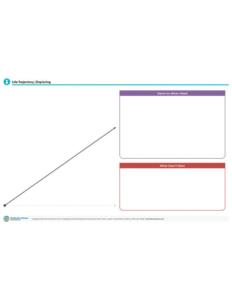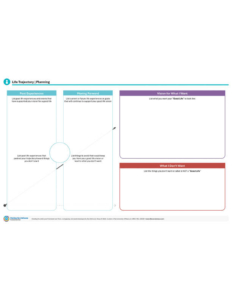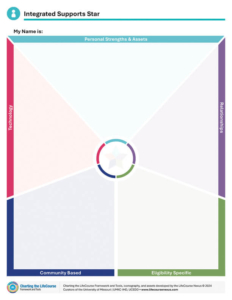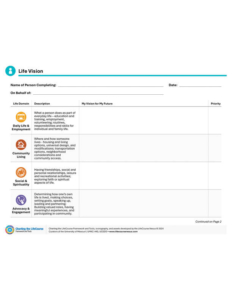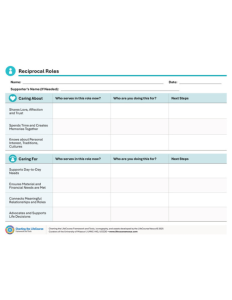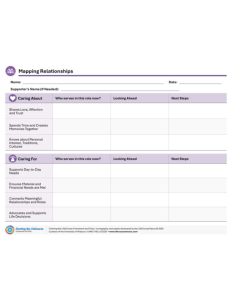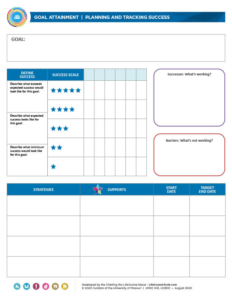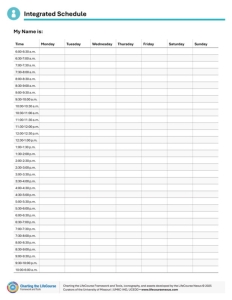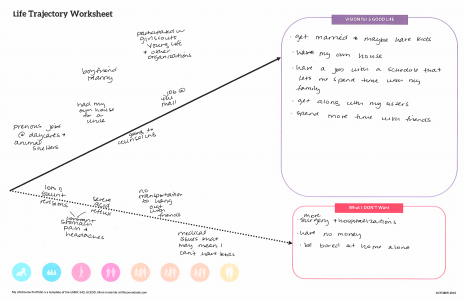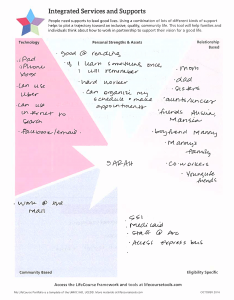Tools to fit your unique needs and aspirations.
CtLC Person-Centered tools are flexible and can be used by anyone, for anything. Use them yourself or find someone that can help you explore, problem-solve, make decisions, or plan for the future. You can use the tools to capture what is important to you, plan for a life transition, set a vision, or think about how to solve any problem in your life – big or small, right now or in the future. The tools can help you to have more meaningful conversations with the people in your life.
Watch the video to the left and see how Crystal shares LifeCourse guided conversations to help her transition-age son express his vision for a good life.
Getting Started
Below is the core set of tools to help you get started on Exploring or Planning Your “Good Life”
Trajectory for Exploring
Create a vision for your good life. The trajectory tool provides space to explore the things going well in your life or the things that are stopping you from reaching your good life.
Click here for the Life Trajectory Tip Sheet: an overview of how and why to use this tool.
Trajectory for Planning
Envision your “good life” and identify the steps or experiences needed to get there. The Trajectory Planning Tool highlights the past life experiences that are leading or moving you away from your vision and then provides space for current goals and things to avoid moving forward.
Integrated Supports Star
Identify the supports you are using now, and think about other supports that might be helpful. The right supports can help ensure your quality of life. Some supports are centered around relationships, technology, or personal strengths and assets. Others are based on eligibility criteria or are supports that anyone in the community can access. Using various supports in combination can help you achieve your vision of a good life.
Life Vision
Forming a vision and beginning to plan for the future in each of the life domains helps plot a trajectory for a full, inclusive, quality life in the community. This tool is to help individuals of all ages start to think about a more specific vision for life in the future and narrow down what life domain(s) to focus on at this point in time.
Reciprocal Roles
The Reciprocal Roles tool will help you identify the people in your life and ways they support you. It also helps you explore ways that you support other people and roles you play in their lives. It can identify gaps as well as the potential for building even stronger relationships.
Mapping Relationships
The Mapping Relationships tool will help you identify the different people and ways that they support you. Some of the people in your life might fulfill a lot of different roles while others might have only one significant role. It can help you have conversations about the future and who may fill those roles when others are no longer able.
Goal Attainment: Planning and Tracking Success
When planning how to achieve a goal, this tool will help you define what success looks like, plan strategies to move closer to the goal, and track progress over time.
Integrated Supports Schedule
The Integrated Support Schedule allows you to create a visual of where and how supports you identified in the Integrated Supports Star can be applied to and used in daily life. It will also help you to identify gaps where more or different support may be needed.
LifeCourse Person-Centered Portfolio
The Charting the LifeCoure Portfolio is designed as a booklet printed on 11×17 paper. It includes the CtLC Trajectory tool on the inside and the Integrated Supports Star on the back. It provides a cover sheet with information about the person.
Person-Centered Portfolio for Exploring:
Includes the trajectory tool with space to explore the things going well in your life or the things that are stopping you from reaching your good life.
Person Centered Portfolio for Planning:
Includes the Trajectory Planning Tool that highlights the past life experiences that are leading or moving you away from your vision and then provides space for current goals and things to avoid moving forward.
All people have the right to live, love, work, play, and pursue their life aspirations in their community.
Charting the LifeCourse Core Belief
Charting the LifeCourse Through Uncharted Waters
Planning for Today with an Eye on the Future
Sheli Reynolds (UMKC-IHD) presented in partnership with the Tommy G. Thompson Center on Public Leadership (UW-Madison) on the Charting the LifeCourse Framework and how everyone can use the framework and tools for planning across the lifespan. This session provides an overview of the framework, principles, and tools and provides application examples across life domains. Examples are also highlighted for how the tools can be used for planning and problem-solving during the COVID pandemic.
Click here to learn more about the Tommy G. Thompson Center on Public Leadership.
How To Use These Tools
Use these tools on your own, or with help from family or other supporters, to talk about your vision, ideas, and life experiences, as you plan, problem solve or work on goals.
Life Trajectory: Person Centered
Watch Video:
In this video, David will explain the idea of “trajectory” as the path to get to where you want to go. He will describe life experiences as the stepping stones that help us reach our vision for a good life. Think about the life experiences you have had that have either taken you to your vision or to what you don’t want, and mark them down on your trajectory (inside of the portfolio).
Integrated Supports Star: Person Centered
Watch Video:
In this video, David will describe the types of support in each section of the Integrated Support Star, share his own personal examples, and give prompts to help you fill out your Integrated Support Star.

